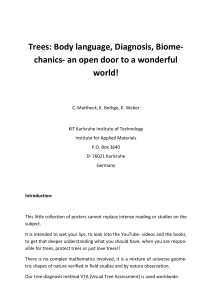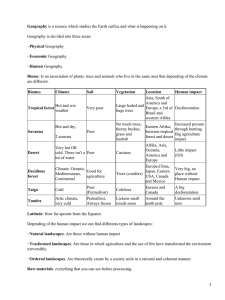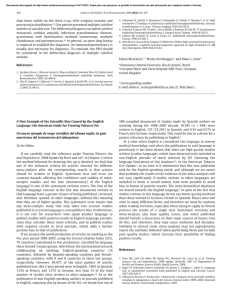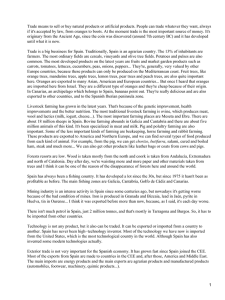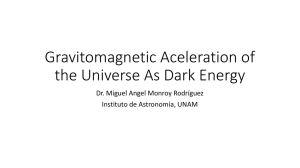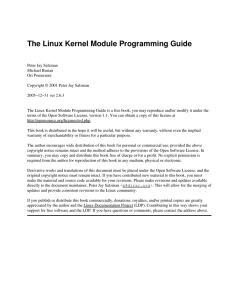An SE-Tree Based Characterization of the Induction Problem
Anuncio
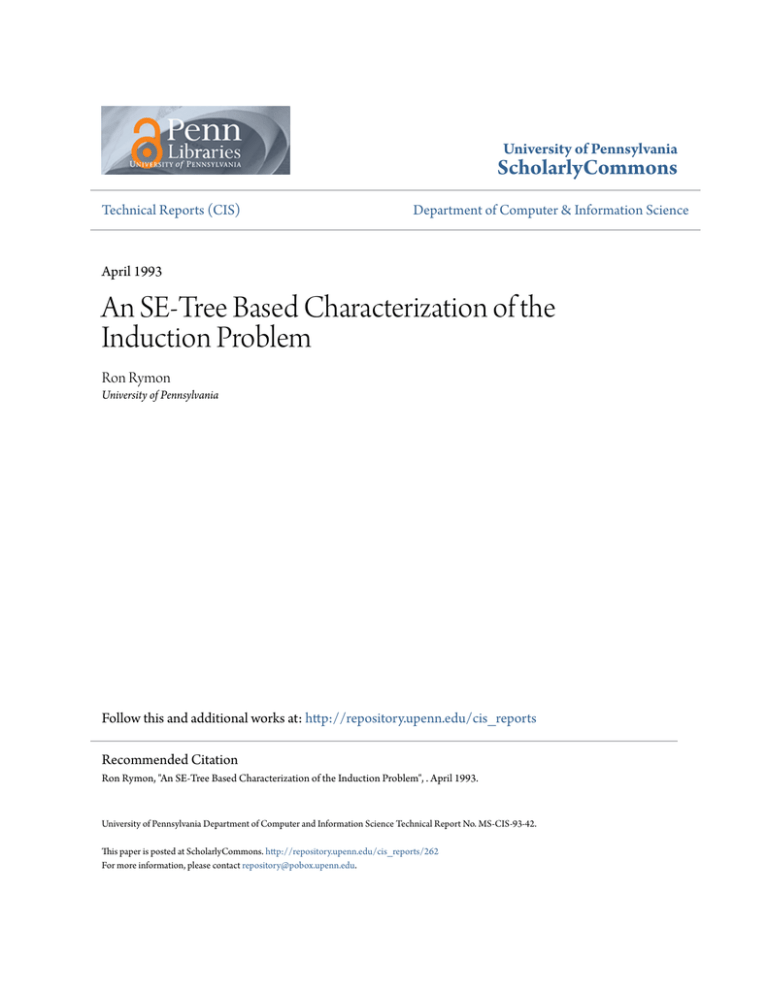
University of Pennsylvania ScholarlyCommons Technical Reports (CIS) Department of Computer & Information Science April 1993 An SE-Tree Based Characterization of the Induction Problem Ron Rymon University of Pennsylvania Follow this and additional works at: http://repository.upenn.edu/cis_reports Recommended Citation Ron Rymon, "An SE-Tree Based Characterization of the Induction Problem", . April 1993. University of Pennsylvania Department of Computer and Information Science Technical Report No. MS-CIS-93-42. This paper is posted at ScholarlyCommons. http://repository.upenn.edu/cis_reports/262 For more information, please contact [email protected]. An SE-Tree Based Characterization of the Induction Problem Abstract Many induction programs use decision trees both as the basis for their search, and as a representation of their classifier solution. In this paper we propose a new structure, called SE-tree, as a more general alternative. Comments University of Pennsylvania Department of Computer and Information Science Technical Report No. MSCIS-93-42. This technical report is available at ScholarlyCommons: http://repository.upenn.edu/cis_reports/262 An SE-tree based Characterization of the Induction Problem MS-CIS-93-42 LINC LAB 248 Ron Rymon University of Pennsylvania School of Engineering and Applied Science Computer and Information Science Department Philadelphia, PA 19104-6389 April 1993 An SE-tree based Characterization of the Induction Problem Ron R y m o n Computer and Information Science University of Pennsylvania Philadelphia, PA 19104 [email protected] (Proceedings Machine Learning Conference, Amherst MA, 1993) Abstract Many induction programs use decision trees both as the basis for their search, and as a representation of their classifier solution. In this paper we propose a new structure, called SE-tree, as a more general alternative. 1 INTRODUCTION Many learning algorithms use decision trees as an underlying framework for search and as a representation of their classifier solutions (e.g. ID3 [Quinlan, 861, CART [Breiman el al., 841). This framework, however, is known t o mix search bias (introduced when the algorithm decides on the order in which attributes are to be used in splitting) with hypotheses-space bias. To avoid being trapped by this bias, several researchers have suggested averaging over multiple trees (e.g. [Buntine, 911). In this paper, still within a recursive partitioning framework, we propose using an alternative data structure called SE-tree [Rymon, 921. On one hand, since the new framework shares many of the features of decision tree-based algorithms. we " should be able to adopt many sub-techniques developed for the latter. On the other hand, an SE-tree embeds a large number of decision trees, thereby providing a more expressive, more flexible, representation for classifiers. Importantly, SE-tree-based algorithms can eliminate almost completely the search bias, admitting instead a user-specified hypotheses-space preference criterion. Section 2 outlines a formal theory of induction where classifiers take the form of collections of rules. Sections 3 and 4 present the SE-tree, and render it useful in searching and representing such collections (the learning phase), and in subsequently using them for classzfication. Incorporation of user-specified bias in either stage, or in both, is described in Sections 4 and 5. Section 6 presents general results relating the SE-tree t o decision trees, with some algorithmic implications. 2 A THEORY FOR INDUCTION Formalizing the induction problem, we will examine collections of production rules that best model the function (concept) represented by the training data. Rules provide a common denominator for decision trees on one hand, and SE-trees on the other, since there is an obvious one-to-one mapping between rules and leaves of such trees. Let us introduce a few useful definitions first: Let ATTRS dgf {Ai)F=+e a set of attributes (also called features or variables), where each attribute A; can take values from a finite unordered discrete domain denoted Dom(Ai). A partial description is a subset of ATTRS, each instantiated from its own domain. An object is a complete partial instantiation, i.e. one in which all attributes are instantiated. By UNIVERSE we refer to the collection of all objects. Consider, for example, a space of 3 binary attributes (A,B,C), hereafter called 3BIN. In SBIN, {A=O,C=l) is a partial description. {A=O,B=O,C=l) is an object. UNIVERSE is 3BIN itself; it is made of a total of 8 objects. A training set (TSET), consisting of objects labeled by their correct class (T),makes an induction problem instance. Example 2.1 (The Checkers Problem) Consider a universe defined by two 3-valued attributes (A,B), and a set of four classes ( a ,P, y , 6 ) . The following figure depicts a training data, and an illustration of UNIVERSE. Having defined a problem instance, we shall try to characterize a solution. Conceptually, we assume the existence of a function (target) from UNIVERSE to the set of classes, and that the training data agree with this function. Our goal is to approximate target over the complete universe, using conjunctive rules as our elementary building blocks. A rule, R , is simply a partial description such that all objects in TSET which agree with it are equally classified, i.e. for every t,t'€TSET, if RCt,t' then a(t) = a(ti). To avoid irrelevant rules, we add the additional requirement that an object matched by a rule is provided in TSET. As a partial description, a rule defines an equivalence class within the universe, namely [R] def { t €UNIVERSE / RCt}. Moreover, since all objects in TSETn[R] agree on their class, we can define .rr([R]) to be that class, and write a production rule of the form R .rr([R]). Thus, from here on, we shall interchangeably talk about a rule as a set of instantiated attributes, as a region in UNIVERSE, and as a conjunction of antecedents. To model a target function, we use collections of rules, interpreted disjunctively for each class. In general, there may possibly be many such collections. The Checkers problem, for instance, admits 8 rules and thus 2' collections. The purpose of an inductive theory is to characterize desirable features of candidate collections. Bias, or preference, expresses the relative desirability of one collection versus another. Our theory has a single bias: for the most part, we will prefer rules that are syntactically simpler. By kernel rules we refer to rules that are most-general (minimal set-wise). Other bias, necessary t o distinguish equally simple hypotheses, is deliberately left out of the theory. Our algorithms will modularly implement a userspecified preference criterion. Consider the Checkers problem again. Only four of the eight rules are also kernel rules: (1) ( A = l ) a a , (2) (B=l)+ P , (3) (B=3)* 7 , and (4) (A=3)+ 6. All other rules, e.g. (A=l)A(B=2)3 a , are subsumed by one or more of the kernel rules. Let C be a collection of rules for a problem instance P, we use Kernel(C) to denote the collection of kernel rules for P that subsume rules in C. The collection of all kernel rules, denoted KRULES, is the target of our induction algorithms. Doing so, we avoid overfi2tin.g of the training data. We propose that over-generalization be dealt with in the classification phase via resolution methods based on the user's reference criterion. Intuitively, while learning, we adopt most-general principles. Rules that are too general will be in conflict with others, and will then be resolved. Definition 2.2 Completeness A collection of rules C is said to be complete w.r.t. TCUNIVERSE if for every t E T , there exists a rule REC such that R C t . Proposition 2.3 1. Let C be a collection of rules that is complete w.r.t. some TCUNIVERSE, then Kernel(C) is also complete w.r.t. T ; 2. KRULES is complete w.r.t. TSET, but is not necessarily complete w.r.t. UNIVERSE. Thus, in the Checkers problem, {A=2,B=2) is not covered by any rule (including non-kernel!). In contrast, any decision tree is complete w.r.t. UNIVERSE. But is completeness desired at all? One may argue that incompleteness of KRULES is often a direct result of important incompleteness of the training data. SEtree-based classification algorithms can, however, extend their coverage by relaxing the rule matching procedure. Definition 2.4 Consistency A collection of rules C is said to be consistent w.r.t. TCUNIVERSE, if for every t € T , and rules R,R7€C,if R , R ' c t , then x([R]) = x([Ri]). P r o p o s i t i o n 2.5 1. Every collection of rules is consistent w.r.t. TSET (by definition), but KRULES may be inconsistent w.r.t. UNIVERSE; 2. Every collection of rules contains a consistent subcollection. Thus, in the Checkers problem, each of the "corner" objects is covered by two contradicting kernel rules (e.g. { A = l , B = l ) is covered by ( A = l ) j a and (B=l)+ P). As per Proposition 2.5(2), KRULES may have (possibly several) sub-collections, the latter may have lesser coverage than KRULES. In contrast, any decision tree zs consistent w.r.t. UNIVERSE. But is consistency desirable at all? KRULES is inconsistent when two rules are over-general to the point in which they contradict one another on as yet unseen parts of UNIVERSE. While ideally, one or both rules need be specialized or removed, the training data alone does not provide us with any suitable preference criterion. An external preference criteria, or bias [Mitchell, 801, must be applied. Bias can be defined as the set of all factors that collectively influence hypothesis selection [Utgoff, 861. [Buntine, 901 divides such criteria into three separate classes: hypothesis space bias are those criteria which specify a preference for one classifier over another; search bias consists of criteria used to guide the actual search for such; and finally, bias may have an application specific component. Adopting Buntine's dichotomy, we believe that an ideal learning system must eliminate search bias. Put differently, bias should be stated by the user, independently from the particular algorithm used. We believe SE-trees represent a step in that direction. So far, we have introduced a single bias - a prefer- ence for kernel rules. Next, when presenting the SELearn family of learning algorithms, we defer the introduction of bias to the latest possible. A variety of user-defined preference criteria can be plugged into the learning and/or classification algorithms. A LEARNING ALGORITHM 3 3.1 SET ENUMERATION TREES Many problems in Computer Science were formalized to admit solutions in the form of sets, or in the form of partial instantiations of a set of variables. Typically, such sets are required to satisfy some problem-specific criterion which designates them as solutions. In ad" dition, where multiple solutions may exist, they are often ranked by their plausibility, likelihood, or desirability. Regularly, such preference involves a minimality (or maximality) criterion, e.g. minimal entropy, maximum probability or utility, etc. Set Enumerution (SE) trees [Rymon, 921 were shown to be useful as the basis for a unifying search-based framework for such domains. SE-trees support complete, irredundant, and prioritized search; their special structure allows for efficient pruning and other optimizations. Let ATTRS%~{Ai}:=l be a set of attributes with domains Dom(A;) respectively, and let ind:ATTRS+W be an indexing of the set of attributes. We define the SE-tree View of a partial description S as follows: Definition 3.1 Extended Set Enumeration Tree The extended SE-tree for a set of attributes ATTRS is defined as follows: 1. At its root is a node labeled with the empty set; 2. Recursively, let S be a node's label, It has children labeled a s follows: Figure 1: Complete SE-tree for 3 Binary Variables 3.2 SE-TREE-BASED LEARNING Aimed at all kernel rules, SE-Learn (Algorithm 3.4) explores top-down an imaginary SE-tree. Nodes are explored by some predetermined priority function. In Sections 4 and 5, we show this prioritization useful in implementing various biases. In expanding open nodes, SE-Learn exploits the SE-tree structure to prune away nodes that cannot lead to kernel rules. SELearn's output is an SE-tree which leaves are labeled with kernel rules. Definition 3.3 Cundzdate and Impotent Expansions Let S be a node, TSET(S) dgf{ t ETSET I S C t ) . We Example 3.2 Figure 1 depicts an extended SE-tree for the complete 3BIN space. Note that restricting a node's expansion to its View, ensures that every member of 3BIN is uniquely explored within the tree. O Representing all elements of a power-set, the complete SE-tree is clearly exponential in size. However, in a large class of problems, especially where solutions are monotonic with respect t o set inclusion, the SE-tree can be used t o induce a complete and yet often efficient search because it allows for systematic pruning [Rymon, 921. def say that S' = SU{A=v) is a candidate expansion of S if A€View(S), v ~ D o m ( A ) However, . S' is impotent if either 1. TSET(S') is empty; or 3. all objects in TSET(S') agree on their assignment to attributes in V i e w ( S 1 )but , there is not a complete agreement on the class (i.e. S' is not a rule). A l g o r i t h m 3.4 tree-based classification algorithms, this is done by following matching paths from the root to class-labeled leaves (rules). Program SE-Learn 1. OPEN-NODES + (4); Recall however that in the SE-tree representation 2. Until OPEN-NODES is empty do 3. Expand (Extract-Min(0PEN-NODES)) Procedure Expand(S) zf 1. For every candidate expansion R SU{A=v) that is not impotent and that is not subsumed by a previously discovered rule do 2. If R is a rule then mark it as such; otherwise add it t o OPEN-NODES. The algorithm works by exploring nodes along the SEtree's current fringe (OPEN-NODES) in a best,-first fashion. For that purpose, nodes are cached in a priority queue and accessed via an Extract-Min operation. Candidate expansions that are not subsumed by previously discovered rules (step 1) are marked as rules if they satisfy the definition or otherwise marked for expansion and added t o the queue for further consideration (step 2). 3.3 EXPLORATION POLICIES An exploration policy is simply the priority function used in Algorithm 3.4 to determine the order in which nodes are explored. I t is easy t o verify that if nodes are explored by their cardinality (breadth-first exploration of the tree) then the algorithm is correct, i.e. it c o m ~ u t e all s andonlv kernel rules. As so far described. any monotonic function +, i.e. such that SCS' implies $ ( S ) 5 +(S1)), results in Algorithm 3.4 being correct. A large class of interesting functions are monotonic, e.g. ones that are based on probability, utility, or information-gain measures. However, at some corn~ u t a t i o n a exDense. l S E L e a r n can be modified t o admit non-monotonic exploration policies as well. The sole purpose of the monotonicity restriction is to avoid recording non-minimal solutions; therefore, to remove it. we need t o also check whether new rules subsume old ones. - Note however t h a t , as so far presented, all exploration policies will result in the same tree structure. The variety of exploration policies allowed will become important next, in specifying and implementing preference criteria. 4 CLASSIFICATION ALGORITHMS Given an SE-tree acquired as above, we want to be able t o use it t o classify new objects. As in decision 1. there may be no such leaf (rule) (we called this incompleteness); or 2. there may be multiple rules (and thus leaves) matching a given object, and they may not always be equally labeled (we called this inconsistency). The SE-tree incompleteness, we argued, is due t o the incompleteness of the training data. One way t o "complete" the SE-tree is t o perform partial matching in cases where there are no perfectly matching rules. The inconsistency property, on the other hand, gives the SE-tree its main power. Roughly, inconsistency reflects a variety of perspectives that could be adopted t o logically partition the training data. In a decision tree, a single such perspective is decided upon at the learning phase in the choice of attribute for each branching point,. Repre~ent~ing multiple perspectives is more expressive and allows more principled resolution. In particular, hypotheses-space preference, explicitly specified by the user, can be used to resolve conflicts. Algorithnl 4.1 uses such preferences directly: by searching the SE-tree best-first with respect to the specified preference, it picks the leaf which maximizes the specified preference from all those matching the object at hand. A l g o r i t h m 4.1 Classification via SE-tree Search I n p n t : (1) an object; (2) an SE-tree; and (3) an exploration policy 4 (bias). P r o c e d u r e : Search SE-tree best-first (according to $), along paths matching the object. Stop when the first leaf is hit, or when the tree is exhausted. O u t p u t : If a leaf was hit, predict its class label. Otherwise, either respond "don't know", or guess, or re-search the tree allowing for partial matching. A illore general approach involves specifying a resolution criterion, e.g. weighted averaging or voting, which takes into account all rules matching a given object. The two approaches can, of course, be combined by applying the resolution criterion to a subset of the rules - those which rank highest by the preference criterion. The following experiment, using the Monks benchmark [Thrun el al., 911, demonstrates the importance of the particular choice of resolution criterion. In general, a preference and/or a resolution criterion should reflect some domain knowledge. However, given the artificial nature of the Monks problems, we experimented with three generic weight functions: simple voting; quadratic (in the rule's size) weight voting, favoring more specific rules; and inverse quadratic, favoring more general rules. In the learning phase, we simply learned all kernel rules. In classification, when the rules were incomplete, we used partial matching. Conflicts were resolved using each of the three weight functions. Figure 2 compares accuracy obtained using each of the resolution criteria to each other; to the average reported for other decision tree-based programs and to the overall average reported for all methods. Note that SELearn's performance is crucially dependent on the resolution criterion used. Accuracy Figure 3: Complexity vs. Accuracy Figure 2: Various Resolution Criteria 5 5.1 BIAS IN THE LEARNING PHASE PARTIALLY EXPLORED SE-TREES It may often be intractable, or practically impossible, to explore all kernel rules. Exploration policies can then be used as early as the learning phase to prune away less promising parts of the SE-tree. Even when all kernel rules can be explored, added complexity may not pay in the margin. Worse, as with many other learning frameworks, more complex SE-trees can even have lower accuracy than their simpler subsets. In such instances, it is standard to use hill-climbing procedures and/or anytime algorithms which explore as time/space permit and return the best classifier seen so far. In SELearn, the SE-tree can be constructed gradually while testing to make sure that the added complexity of new rules is worth the marginal improvement in accuracy. When interrupted, or when it runs out of resources (particularly space) this procedure will return the best classifier it has seen so far. The particular exploration policy used plays an important role in this procedure since it determines the order in which rule nodes are seen. Using again the Monks problems, we ran an experiment in which an SE-tree was explored level by level. The change in complexity (measured by the number of rules) and in accuracy (using the inverse quadratic resolution criterion) is depicted in Figure 3. 5.2 S P E C I A L C O L L E C T I O N S OF R U L E S In what follows, we briefly describe variations of SELearn that compute SE-trees corresponding to collections of rules with special features. Here too, the par- ticular collection computed is determined by the exploration policy. C o n s i s t e n t Sub-Collections of K R U L E S A collection of kernel rules is inconsistent w .r.t. UNIVERSE iff it has rules R1, Rz such that x ( [ R ~ ] ) # x ( [ R ~and ] ) no attribute appears in both R1Rs, and R2-Rl. Thus, SE-Learn could be modified not to retain rules which are inconsistent with vreviously discovered rules. Since the order in which Lodes are explored determines which rules are retained, the particular exploration policy used defines a bias. Mininlal Sub-Collections of K R U L E S For TSET-completeness purposes, a rule R is redundant if every object in TSET that R matches is also matched by another rule R'. As before, one can modify SE-Learn so as not to retain rules deemed redundant by previously discovered rules. Another alternative is to restrict redundancy to n rules per training instance, or to rules that satisfy some other acceptance criterion such as statistical significance. Again, the particular exploration policy defines a bias. C o n s i s t e n t a n d C o m p l e t e Collections of R u l e s The down side of discarding inconsistent rules, as suggested above, is that the collection of rules obtained may be incomplete even w.r.t. TSET. To avoid this, rather than discarding such rules, SE-Learn can be modified to further expand them. The collection of rules so obtained are guaranteed to be complete. However, individual rules may no longer be kernel. Minilnal a n d C o n s i s t e n t Collections By removing both inconsistent and redundant rules, one may get a minimal collection of rules that is both complete and consistent. SE-TREE AND DECISION TREES 6 A number of decision tree based algorithms have had an impact on machine learning research. Part of our purpose here is t o convince researchers to look at the SE-tree as a more general alternative to decision trees. We devote this section to a broader comparison of the two data structures. 6.1 A FOREST OF DECISION TREES One wav to view a decision tree is as an SE-tree in which every possible object has exactly one path along which it can be classified, i.e. an SE-tree that is consistent and complete w.r.t. UNIVERSE1. Conversely, one way to view an S E t r e e is as a collection, or forest, of decision trees. A single SE-tree can be shown to embed a large number of decision trees. In particular, let D be a decision tree in which attributes were chosen monotonically w.r.t. some indexing function. Let S be an S E t r e e constructed in accordance to same indexing function, then S embeds D , i.e. there exists a subset of S's edges which forms a tree that is topologically and semantically equivalent to D , and that is rooted at S's root. One articular decision tree is the SE-tree's primary decision tree: the one in which each internal node is expanded with the first attribute in that node's SE-tree View that does not result in impotent expansions. This result can be strengthened to make the SE-tree embed any single decision tree2. In particular, let D be a decision tree that is constructed by any ID3-like procedure. To create an SE-tree that embeds D we may have to slightly alter the definition of an SE-tree to allow for dynamic re-indexing. In particular, we will develop an indexing as we create the tree: 6.2 IMPROVING UPON A GIVEN DECISION TREE An important corollary of the result above is that one can construct an exploration policy under which SE-Learn will start off with one's favorite decision tree, and then try to improve it by adding more rule nodes. (This exploration policy may be nonmonotonic though.) Of course, rule nodes will only be added to the extent in which accuracy (as tested empirically on a separate training set) is improved. We have tested this approach on the Monks benchmark. In each of the three problenls, we started with a decision tree constructed by the information-gain criterion. Then, the rest of the SE-tree was explored breadth-first. Accuracy and complexity were recorded for the primary decision tree, and for each level of the tree in which rules were added (Figure 4). Accuracy Size Figure 4: Starting from a Decision Tree Note that in all three problems, the accuracy of the primary decision tree could be improved by adding SEtree nodes, although this improvement is not mono2. Then, while at a node labeled S, let i ~ . d ~ ~tonic. ~ ~ Also ~ note ~ ( that ~ ) in Monkl, adding the SE-tree's first level has not only improved the accuracy, but has be the indexing used in expanding S's parent. also reduced the number of rule nodes (some decision In S, we use an indexing which coincides with tree rules were pruned because they were subsumed by ind,,,,,,t(s) on all attributes not in View(S), but newly discovered rules). may re-order attributes in View(S) as we wish. In particular, if a node corresponding to S appears in 6.3 HYPOTHESES EXPRESSIBILITY D , we will re-order attributes in Vietu(S)so that the first attribute used in D to split that node Consider the following problem instance: appears first. 1. At first, we will choose an initial indexing indrOot in which the first Sttribute used in D appears first; By construction, D will be embedded in an SE-tree created as above as its primary decision tree. It is fairly easy t o verify that the SE-tree remains complete and irredundant, and that SE-Learn remains correct. 'An SE-tree, however, can be consistent and coniplete without being a decision tree. ' N o t all of them at once; rather a collection that includes a specific decision tree. - Class 1 l O l O l 0 I A 11111 1 While four different hypotheses are consistent with le~ this training data, there are only two 1 ~ 3 - s t ~de- [A I B I I 3 ~ h e r eare rnore decision trees, but only these can be generated by an ID3-like procedure. cision trees (Figure 5). The corresponding SE-tree contains (as subset of its arcs) both trees, and can be used to represent all four hypotheses depending on the particular exploration policy (bias) used in a given classification session. (a) Decision Trees in the tree are necessary for some, but not all, the rules. The minimality problem is often addressed by subsequently pruning the rules extracted from the decision tree (e.g. [Quinlan, 871). The replication problem, a special case of multiplicity in which whole subtrees are replicated, has been addressed by several researchers (e.g. [Rivest, 87, Pagallo & Haussler, 901). Inco~npleteness,which is only a problem if one is really interested in all kernel rules, results from the insisted mutual exclusivity of any decision tree's leaves (see [Weiss & Indurkhya, 911). None of these problems occurs in the SE-tree-based framework: 1. Rules are always discovered in their kernel form; 2. Kernel rules are always discovered uniquely; and 3. All kernel rules are discovered. 6.5 COMPLEXITY (b) SE-Tree Figure 5: SE-tree versus Decision Trees Consider, for example, an O R function (not modeled by either decision trees). In SE-Learn, if a searchbased approach to classification is adopted (Algorithm 4.1), an O R function can be implemented using an exploration policy that assigns high priority to the arcs A = l and B=l. Generalizing this problem to n attributes, each taking its values from (0 . . .n - 1)' we are given a training set with the n cases in which all attributes, and the class, are equally labeled. Now, we consider a function that takes the most frequent value among its attributes, with bias towards higher values in case of equality (for n = 2, we get the OR function). Such function cannot be modeled by any of the ID3style decision trees4, but can easily be modeled using an SE-tree with a resolution criterion based on simple voting. 6.4 COMPUTING KERNEL RULES Considering the goal of computing all kernel rules, three problems may arise in a decision tree-based search framework: 1. The minimality problem - rules will often not be discovered in their minimal (kernel) form; 2. The multiplicity problem - each kernel rule may be discovered multiply, disguised in a number of its non-minimal supersets; and 3. The incompleteness problem - some kernel rules may not be discovered at all. Both the minimality problem and the multiplicity phenomenon result from the fact that attributes used high 41n fact, a decision tree modeling this function is necessarily exponential. The SE-tree's exhaustiveness and large initial branching may be deceiving. Let us first compare its worstcase complexity to that of a decision tree, independently of their use. Propositioll 6.1 If all attributes are b-valued, then the number of nodes in a conlplete decision tree is bn bn-I + . . . b + 1 > bn. The size of a complete SE-tree is ( b l ) n . In sharp contrast, the size of a super-tree containing all decision trees is significantly larger: bn . n!. + + Within an induction framework, however, one rarely explores a complete decision tree (nor a complete SEtree for that matter). In an ID3-like framework, the size of a decision tree is linear in the size of the training data. This is not true of SE-Learn! Kernel rules are close relatives of prime-implicants, and as such we know of pathological examples in which the number of kernel rules is exponential in the size of the training data. On the other hand, as just explained, one does not have to e x ~ l o r ethe entire SE-tree and one can always have t h i f i r s t nodes explored be those of one's favorite decision tree. 7 CONCLUSION AND FUTURE RESEARCH DIRECTIONS We have proposed an inductive learning framework which uses an SE-tree as a basis for search and classifier representation and have presented a family of algorith~nsfor SE-tree induction and for SE-tree-based classification. We have shown that as a representation for classifiers, SE-trees generalize decision trees in two ways: first, a decision tree is a special case of an SE-tree, and second, an SE-tree contains many decision trees. An SE-tree can also be built by improving upon one's favorite decision tree. However, unlike decision trees, nlost of the search bias can be eliminated in SEtree-based algorithms; an independently specified hypothesis-space bias can be used instead. Importantly, the SEtree-based framework can borrow from techniques developed for decision trees. In particular 1. More expressive representation languages can be adopted, e.g. ordered and hierarchical variables, multi-variable tests, class probability trees, etc. Discretization techniques, and criteria developed for selecting a splitting test can be used to handle ordered variables; averaging and smoothing techniques can be used in conjunction with class probabilities representation. 2. Pruning techniques developed for decision trees, e.g. using statistical significance tests, can also be used in SE-trees. 3. Entropy-minimization and other criteria developed for selecting the next splitting attribute in decision trees will likely be useful in selecting an indexing function for an SE-tree which will minimize the number of nodes that have to be explored. More research, however, is needed to figure ways in which these techniques can be deployed effectively. Other areas of future research include general and domain-specific exploration policies and resolution criteria, termination criteria suitable for various tradeoffs between accuracy and time/space, and an incremental version of SE-Learn. Recent advances in search algorithms lend themselves to improved implementation of the SE-treebased framework, e.g. linear-space best-first search algorithms [Korf, 92, Russell, 921 and a SIMD version of IDA* [Powley et al., 931. Acknowledgements The idea of using the SE-trees to learn rules originated at a talk by Tom Mitchell - I thank him for that, as well as for later suggestions. I also thank Kevin Atteson, Russ Greiner, Haym Hirsh, Alon Luss, TeowHin Ngair, Michael Niv, Greg Provan, Philip Resnik, Nick Short, Scott Weinstein, and anonymous reviewers for commenting on previous drafts. This work was supported in part by a graduate fellowship ARO grant DAAL03-89-C0031PRI. References [Breiman e l al., 841 Breiman, L., Friedman, J ., 01slien, R., and Stone, C., Classification and Regression Trees. Wadsworth, Belmont, 1984. [Buntine, 901 Buntine, W., Myths and Legends in Learning Classification Rules. Proc. AAAI- 90, Boston, MA, pp. 736-742, 1990. [Buntine, 911 Buntine, W., Learning Classification Trees. Technical Report, NASA Ames Research Center, 1991. [Korf, 921 Korf, R. E., Linear-Space Best-First Search: Summary of Results. Proc. AAAI-92, San Jose CA, 1992. [Mitchell, 801 Mitchell, T . M., The Need for Biases in Learning Generalizations. Technical Report 5-110, Rutgers University, 1980. [Pagallo & Haussler, 901 Pagallo, G., and Haussler, D ., Boolean Feature Discovery in Empirical Learning. Machine Learning, 5, pp. 71-99, 1990. [Powley et al., 931 Powley, C., Ferguson, C., and Korf, R . E., Depth-First Heuristic Search on a SIMD Machine. Artificzal Intelligence, 60, 1993, pp. 199242. [Quinlan, 861 Quinlan, J . R., Induction of Decision Trees. Machine Learning, 1(1):81-106, 1986. [Quinlan, 871 Quinlan, J . R., Generating Production Rules from Decision Trees. Proc. IJCAI-87, pp. 304-307, 1987. [Rivest, 871 Rivest, R., Learning Decision Lists. Machine Let~rning,2, pp. 229-246, 1987. [Russell, 921 Russell, S., Efficient Memory-Bounded Search Algorithms. Proc. ECAI-92, Vienna, Austria, 1992. [Rymon, 921 Rymon, R., Search through Systematic Set Enumeration. Proc. KR-92, Cambridge MA, 1992. [Thrun et al., 911 Thrun, S. B., Bala, J . , Bloedron, E., Bratko, I., Cestnik, B., Cheng, J . , De Jong, K . , Dzeroski, S., Fahlman, S. E., Fisher, D., Hammann, R . , Kaufman, K., Keller, s . , Kononenko, I., Kreuzinger, J . , Michalski, R. S., Mitchell, T., Pachowicz, P . , Reich, Y., Vafaie, H., Van de Welde, W., Wenzel, W., Wnek, J . , Zhang, J., The MONIi's Problen~s- A Performance Comparison of Different Learning Algorithms. Technical Report CMU-CS-91-197, December 1991. [Utgoff, 861 Utgoff, P. E., Machine Learnzng of Inductive Bias. Kluwer Academic, Boston MA, 1986. [Weiss & Indurkhya, 911 Weiss, S. M., and Indurkhya, N ., Reduced Co~nplexityRule Induction. Proc. IJCAI-91, pp. 678-684, Sydney, Australia, 1991.
